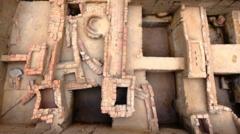A recent DNA analysis of a 4,500-year-old skeleton discovered in the Nile Valley is revolutionizing our understanding of ancient Egyptian history. This remarkable fossil belonged to a man who likely worked as a potter and lived until the age of 60, but the most astonishing revelation is that one-fifth of his DNA traces back to ancestors who inhabited Mesopotamia, now modern-day Iraq. This is the first biological evidence highlighting the links between two of the world's most influential ancient civilizations.
Researchers at Liverpool John Moores University, under the leadership of Prof. Pontus Skoglund from the Francis Crick Institute, hope that analyzing ancient DNA will provide a vibrant backdrop to historical events, translating the cold facts of written records into a more nuanced narrative. Traditional accounts often focus on the powerful elite, but DNA evidence allows historians to investigate the lives of ordinary individuals.
The DNA was extracted from a bone located in the inner ear of the remains, discovered in a ceramic coffin in Nuwayrat, a village south of Cairo. The man lived during a pivotal era that saw the dawn of major civilizations, as archaeological findings had suggested connections between regions over 10,000 years ago. Until this study, direct evidence of contact between these two areas was lacking.
Adeline Morez Jacobs, a researcher at Liverpool John Moores University, emphasized the significance of these findings, stating it represents the first clear evidence of migration and communication between Egypt and Mesopotamia. With both societies developing early writing systems, the findings lend credence to the theory of collaborative influence in their respective advancements.
In addition to revealing migratory patterns, the research team learned about his diet and upbringing through chemical analysis of his teeth, indicating he was raised in Egypt. The meticulous study of his skeletal structure also painted a detailed picture of his daily life—an individual significantly short in stature for his time, with signs of extensive labor.
Due to a series of fortunate circumstances, including the man’s burial method before mummification became common, researchers were able to glean DNA from the remains that survived the World War II bombings of a museum containing the skeleton. The findings were published in the journal Nature, marking a significant advancement in the study of ancient civilizations and the potential to uncover their intriguing narratives.




















